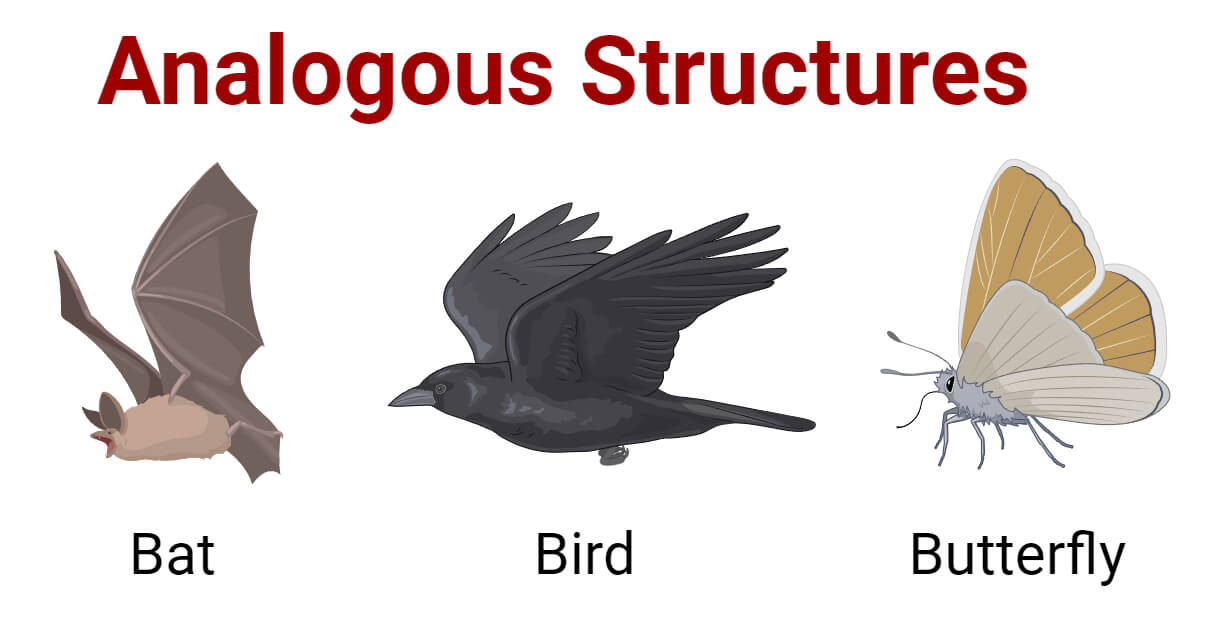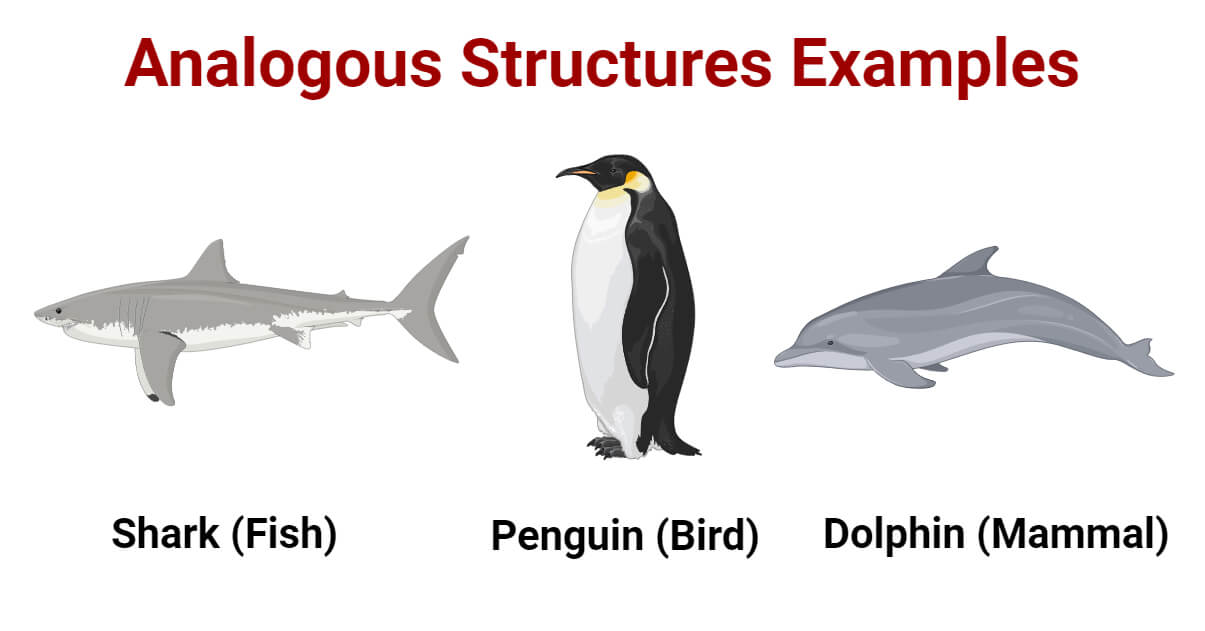Evolution is the driving process of nature through which new species arise from their ancestral forms. The concept of evolution is essential for understanding how life on Earth has developed over time. One of the important concepts in evolution is convergent evolution, which helps us understand how different species can independently develop similar traits in response to similar environmental conditions. Convergent evolution leads to the formation of analogous structures.

Throughout the evolutionary history of life on Earth, there are circumstances where organisms within the same or similar environments descend from different evolutionary origins, yet exhibit functionally similar traits called analogous structures. They develop similar traits in response to the shared ecological environment. These structures serve similar functions, even though they originated independently in different lineages.
Analogous structures support the idea that species can adapt to their surroundings over time, resulting in a diverse array of life. Analogous structures demonstrate that different species can, through entirely separate evolutionary pathways, arrive at similar solutions to the challenges presented by their environments.
Interesting Science Videos
What are analogous structures?
Analogous structures are defined as the structures or traits of different or unrelated organisms that perform similar functions but have different evolutionary origins.
These traits evolve in response to similar environmental conditions.
- The similarity in analogous structures can exist at the phenotypic level, but the underlying DNA sequences are different.
- These structures provide insights into the ways in which different species adapt and thrive in response to their surroundings.
- Evolutionary biologists use various methods, including molecular and DNA comparisons, fossil evidence, and phylogenies to identify and study analogous structures.
Examples of analogous structures
- Fins in Fish and Dolphins: A classic example of analogous structures is the fins of dolphins and sharks. Despite these creatures not being closely related, they both developed fins due to similar environmental demands. Both fish and dolphins have fins that assist in swimming.

- Wings in Birds and Bats: Another example of analogous structures is found in the wings of bats and bees. Bats and bees have wings that help them fly, but they do not have a common ancestor. While the external appearance of these wings is similar, their internal structures are significantly different. Bat wings possess a bony framework with muscles, while bee wings are membranous.
- Eyes in Mammals and Octopuses: The eyes of mammals and octopuses are another example of analogous structure. Despite belonging to different animal classes, their eyes have independently evolved to be similar.
- Wings in Insects and Birds: In both insects and birds, wings are used for flight. Insects are arthropods, and birds are vertebrates but their wings have evolved to serve the same function of flying.
What is Convergent Evolution?
Convergent evolution is the evolution of organisms from different ancestors with functionally similar traits or structures. These structures appear similar in their function or form, but they do not share a common ancestor.
- Convergent evolution can happen through three main processes: independent mutations occurring separately in different groups, the evolution of advantageous alleles in a shared ancestor, and the introduction of alleles through hybridization between different populations.
- Convergent evolution occurs when different species find themselves in similar environments and face similar selective challenges. As a result, they independently adapt in similar ways to survive and thrive in those conditions.
- Convergent evolution results in the formation of analogous structures.
Comparison between analogous and homologous structures
| Analogous Structures | Homologous Structures |
| These are similar structures or traits in different species that have the same function but different evolutionary origins. | These are structures or traits that share a common evolutionary origin, although they may serve different functions. |
| They do not share a common evolutionary ancestor and do not indicate a close evolutionary relationship between species. | They share a common evolutionary ancestor and indicate a close evolutionary relationship between species. |
| They are structurally similar on the surface due to functional similarities but have different internal structures. | They can be structurally similar both externally and internally due to shared ancestry. |
| These structures result from convergent evolution, where unrelated species independently develop similar structures. | These structures result from divergent evolution, where a common ancestor gives rise to species with different traits. |
| Example: both bat wings and bee wings are used for flight. | Example: The human arm and bat wing have similar limb bones but different functions. |
Significances of analogous structures
- Analogous structures contribute to our understanding of the evolutionary history of different species.
- Analogous structures help understand how species have adapted to their environments over time. These structures help to study the role of natural selection and adaptation in shaping organisms.
- Analogous structures provide evidence for convergent evolution. They demonstrate that unrelated species can independently develop similar traits when faced with the same environmental challenges.
- Analogous structures demonstrate the diversity and adaptability of different life forms on Earth.
- Classifications based solely on common traits can be misleading as these traits do not necessarily indicate a close evolutionary relationship. So, it is important to understand the concept of analogous structures to avoid misleading taxonomic classifications.
References
- Analogous Structures – Definition, Properties, Examples, and FAQs (geeksforgeeks.org)
- Analogous Structures | Overview & Examples – Video & Lesson Transcript | Study.com
- Gabora, L. (2013). Convergent Evolution. Brenner’s Encyclopedia of Genetics, 178–180. doi:10.1016/b978-0-12-374984-0.00336-3
- Scoville, Heather. “Analogous Structures in Evolution.” ThoughtCo, Sep. 7, 2021, thoughtco.com/about-analogous-structures-1224491.
- Stayton, C. T. (2015). What does convergent evolution mean? The interpretation of convergence and its implications in the search for limits to evolution. Interface Focus, 5(6), 20150039. doi:10.1098/rsfs.2015.0039
- Stern, D. L. (2013). The genetic causes of convergent evolution. Nature Reviews Genetics, 14(11), 751–764. doi:10.1038/nrg3483
- 18.5G: Convergent Evolution – Biology LibreTexts
- 5.21: Homologous and Analogous Traits – Biology LibreTexts
- Analogous structures – Definition and Examples | Biology Online

This is great! May I use this information for my science class?
Hi Deidra, Thanks, sure you can use this information for your science class.